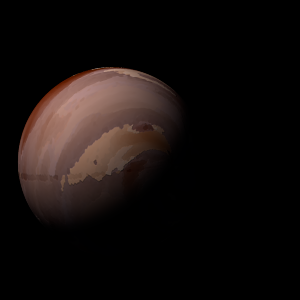|
|
Space Astro
|
Info for exoplanet "Ariel Tripa-dil"
| Scientific (actual) data |
|---|
| Name | Kepler-490 b |
| Planet status | Confirmed |
| Radius | 1.039 |
| Orbital period | 3.2687 |
| Discovered | 2016 |
| Updated | 2021-02-05 |
| Tconj | 2454970 |
| Publication | Announced on a website |
| Detection type | Primary Transit |
| Alternate names | 2MASS J19400616+4657216 b, K00199.01, KIC 10019708 b, KOI-199 b, KOI-199.01, WISE J194006.15+465721.5 b |
| Star name | Kepler-490 |
| Right ascension | 295.03° |
| Declination | 46.96° |
| Mag j | 13.819 |
| Mag h | 13.502 |
| Mag k | 13.469 |
| Star distance | 1249 |
| Star metallicity | -0.02 |
| Star mass | 1.08 |
| Star radius | 1.12 |
| Star age | 3.47 |
| Star temperature | 6045 |
| Star alternate names | 2MASS J19400616+4657216, KIC 10019708, KOI-199, WISE J194006.15+465721.5 |
| Wikipedia article | Kepler-490 b |
Back
| |
| Fictional info (?) |
|---|
| Suggested name | Ariel Tripa-dil |
| Planet type | Cold planet |
| As seen relative to the fixed stars, it rotates on its axis exactly three times for every four revolutions it makes around Kepler-490. As seen from Kepler-490, in a frame of reference that rotates with the orbital motion, it appears to rotate only once every two years.
The volume of water detected has been estimated to be equivalent to the volume of water in the Black Sea. |
| Atmosphere | Hydrogen peroxide | 30% |
| Ozone | 25% |
| Hydrogen deuteride (HD) | 22% |
| Carbon monoxide | 13% |
| Nitric oxide | 10% |
| Oxygen | 0.15% |
| Atmospheric pressure | 0.011 bar |
 |
| Moon | Thegaret Nephocli | Medium-sized round oceanic asteroid |
| Deneenbeb Rok | Small slightly egg-shaped ice moon |
| Kalgala-saxa | Medium-sized almost round rocky planetoid |
| Kateke Duspro | Large slightly egg-shaped crater-filled moon |
| Culotea Hi | Very small slightly egg-shaped rocky asteroid |
| Nomepsa-pathel Spon | Very small slightly egg-shaped oceanic moon |
| Berda Auto Nand | Large slightly egg-shaped rocky moon |
| Meapro Fenlene | Very small almost round oceanic moon |
| Demelene-masao | Small almost round rocky asteroid |
| Dilsatho Raxiet | Small potato shaped rocky moon |
| Doraor'greip | Small irregular ice moon |
| Rirfer-lene | Very small round rocky comet |
| Laprothy Taypaa | Small almost round ice moon |
| Theamedeia-dei | Small irregular gaseous moon |
| Briel | Large almost round ice comet |
| Sore'stemas Te | Small potato shaped rocky asteroid |
| Lapero Ronsi-io | Small irregular rocky comet |
| Kaphaë | Medium-sized slightly egg-shaped crater-filled planetoid |
| Theus | Very small irregular crater-filled comet |
| Rheanaq'erti | Very small slightly egg-shaped crater-filled planetoid |
| Munnand-ellydi Mas | Medium-sized round crater-filled comet |
| Google search for Ariel tripa-dil |
|
Website by Joachim Michaelis
|
|
|
|